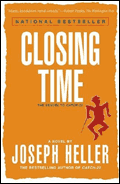 This book review was originally published on Critics’ Choice on March 21, 1995.
This book review was originally published on Critics’ Choice on March 21, 1995.
World War II bombardier John Yossarian wants to know if he can be exempt from flying any more missions because he’s insane. Of course, comes the reply, but in order to be declared insane you have to consult a doctor, and only someone of compos mentis would consult a doctor.
Catch-22.
Here’s another one: an aging novelist wants to end his career with a novel as brilliant and innovative as his first. But the only way he can be truly original is by pirating from the first book, which makes him just another has-been stuck in a slump.
Sadly enough, that’s the predicament novelist Joseph Heller has written himself into with his new novel, Closing Time, which publisher Simon & Schuster is billing as the sequel to his groundbreaking 1961 work Catch-22. A sprawling domestic satire that tracks down Catch protagonist John Yossarian fifty years later, Closing Time pales not only in comparison to the rest of the Heller oeuvre, but to many of his imitators’ works as well.
The Yossarian we meet in Closing Time has decided, after a lifetime of lifeless copy writing and advertising jobs, to throw ethics to the wind and help old World War II cohort Milo Minderbinder sell his M & M E & A Sub-Supersonic Invisible and Noiseless Defensive Second-Strike Offensive Attack Bomber to the government. Yossarian quells his ethical dilemmas by reasoning that a) Milo won’t actually build the bomber once he’s got the money for it, b) Yossarian will probably be dead before the first plane makes it off the assembly line, and c) Milo’s paying him good money.
Yossarian only moonlights as a war profiteer, however. He’s also in charge of planning the most expensive, wasteful wedding ever to grace the Big Apple, and he’s decided to stage it at the Port Authority Bus Terminal. With an exorbitant million-dollar wedding cake and a cast of actors playing the various prostitutes, thugs, and drug pushers that normally inhabit the terminal, the wedding gives Heller ample opportunity to display his trademark venom at the absurdities of twentieth-century life.
Unfortunately, Heller chose to mix the narratives of two additional protagonists with the further adventures of John Yossarian. These chapters devoted to fellow septuagenarians Sammy Singer and Lew Rabinowitz move by at a snail’s pace, filled mostly with tedious reminiscences about the heyday of Coney Island and whining Andy Rooneyesque diatribes about the state of today’s youth.
Heller’s main problem in concocting a sequel to Catch-22, however, is that its predecessor was too successful. Back in the early ’60s before civil disobedience became fashionable, the idea of, say, Yossarian sitting naked in a tree during a fellow pilot’s funeral was unbelievably caustic and biting. In the ’90s, that type of wit has become the mainstream in humor. Today you can get something equally raw from your garden-variety cable comedian, or even a mediocre episode of “The Simpsons.”
There’s also a strange sense of ironic self-awareness running through Closing Time that gives the book an aura of recycled goods. Winking references are made to Catch-22s and a writer named “Joey Heller”; Rabinowitz rubs elbows with the author’s old buddy, Kurt Vonnegut, in the maple syrup factories of Dresden, Germany; even Yossarian’s courtship of his nurse bears striking resemblance to the real-life courtship of Heller and his nurse related in the autobiographical No Laughing Matter.
So what’s left? Plenty of jokes directed at the video game junky Vice-President with the Secret Service code name “Little Prick,” who’s obviously supposed to be Dan Quayle. (Haven’t we all heard enough of those jokes?) There’s also a smattering of the old vaudevillian Heller dialogues, such as this one in which Milo Minderbinder and pals go to bat for his stealth bomber before a government commission:
“And what does a flying wing look like?”
“Other flying wings,” Wintergreen interposed adroitly, with Milo struck dumb by a query he had not anticipated.
“And what do other flying wings look like?”
“Our flying wing,” answered Milo, his composure restored.
“Will it look,” asked a major, “like the old Stealth?”
“No. Only in appearance.”
Scenes like the previous one show that Heller can still be lots of fun when he wants to. But most of the rest of Closing Time is neither fun nor particularly insightful, and the book’s apocalyptic ending — curiously swiped from the Stanley Kubrick/Terry Southern film Dr. Strangelove — is an exercise in depression without purpose.
Joseph Heller was right in the introductory note to his first novel: there’s only one catch, and that’s Catch-22.
My father flew approximately 20 – 25 missions along-side Joseph Heller. I recall
some of the stories my father told me. Dad and Joe had communications, mostly
by mail in 1992-1994, when Joe was asking for assistance in recalling some of the
WWII activities they worked on. Joe mentions dad in “Closing Time” on six pages-
217,218,239,341,342 and 347… I possess a signed copy of Closing Time dated
September 5, 1994… WAS